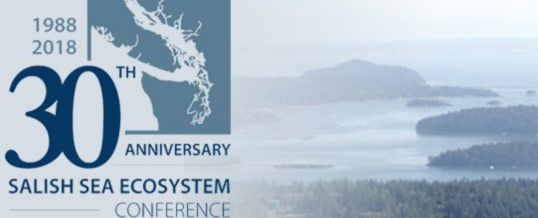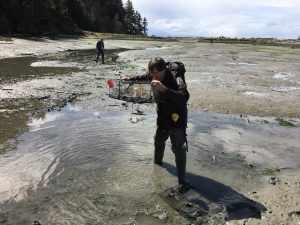
April 27, 2018
Yesterday’s blog post covered the highlights from the first green crab special session at the 2018 Salish Sea Ecosystem Conference. Today, we’ll break down the second special session that focused on management of invasive European green crab and provide some reflections on the conference as a whole.
Session 2: “Addressing European Green Crab in the Salish Sea: A Rare Opportunity for International Collaboration Toward Effective Aquatic Invasive Species Control and Prevention”
During the second session we heard from five panelists: Robert Duff, Natural Resource and Environment Policy Advisor in the Office of Washington Governor Jay Inslee, Erin Ewald, Assistant Director of Regulatory and Environmental Compliance at Taylor Shellfish, Lorenz Sollmann, Deputy Project Leader at the Dungeness National Wildlife Refuge from the U.S. Fish & Wildlife Service, Deborah Jensen, member of the Puget Sound Partnership Leadership Council, and Pat Stevenson, Environmental Manager of the Stillaguamish Tribe and Vice Chair of the Washington Invasive Species Council. The session included discussion of opportunities and challenges for management and policy of green crab. Robert Duff pointed out that there is often less political motivation to provide funding for prevention projects where the consequences of not taking action are uncertain. Compared to a restoration project where, in the eyes of an elected official, there may be a more immediately visible outcome, the benefits of preventative action may be less clear. Erin Ewald also expressed concern over the potential for policy and increased regulation that could hamper aquaculture and shellfish industries that are an important part of Washington’s economy.

Lorenz Sollmann inspecting a trap at Dungeness Spit. Photo: Allen Pleus/WDFW
However, despite these challenges, panelists expressed strong support for management efforts in the near future. Lorenz Sollmann emphasized the prime opportunity that is presented by taking action before green crab become established, saying, “we’re at the right place, at the right time, with the right team players— and I’d like to capitalize on that.” In light of Dr. Tepolt’s genomic work and Elizabeth Brasseale’s modeling work, Sollmann’s call to action is even more pertinent at Dungeness Spit. Pat Stevenson expressed a similar sentiment, pointing out that tribes are invested in their shellfish, so it’s better to be ready for an invasion of green crab that could impact those shellfish rather than let the invasion get away from us. Finally, while not all panelists were willing to say that management of green crab is of highest priority for policy action in the Salish Sea, panelists did agree that continued monitoring through WSG Crab Team is critically important to ensure that we are able to take direct management action when ready. The panelists also expressed interest in expanded monitoring on both sides of the U.S.-Canada border.
Closing Thoughts
Bringing together a variety of scientists and stakeholders involved in European green crab research and management in Washington’s Salish Sea was a great opportunity for Crab Team to demonstrate the value of the three years of monitoring that program volunteers and partners have made possible, and to learn what challenges and opportunities are still ahead. Though there are many factors to consider in approaching the management of this pesky crab, the new insights we gained at the conference arm us with knowledge that can be used to better communicate and collaborate with all stakeholders involved in this emerging issue. Moving forward, Crab Team will continue its work with Washington Department of Fish and Wildlife & Department of Fisheries and Oceans Canada to discuss the potential for management of European green crab in the Salish Sea.
– Kelly Martin
Learn more about the 2018 Salish Sea Ecosystem Conference at this website, or check out some of the highlights on Twitter by searching for #SSEC18
Featured Photo: From the SSEC website
APR
2018